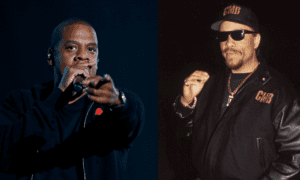
Beats of the Ninth: September’s Historic Hip-Hop Releases
September has etched its name in gold. It’s a month that carries a remarkable significance in the history of Hip-Hop. This article delves into the evolution and impact of classic hip-hop albums released in September that continue to make waves. We’ll traverse the decades, from the roots of these genres to the birth of iconic records that continue to resonate with audiences today.
Unravel the stories behind the beats with our Best Hip-Hop Albums of All Time feature.
Graduation – Kanye West (September 11, 2007)
Mr. West Received a Diploma
Graduation, Kanye West’s seminal album, was unveiled to the world on September 11, 2007. It was in fierce sales competition with 50 Cent’s Curtis at its release. This didn’t overshadow the distinctiveness of West’s project, particularly given its Takashi Murikami-designed album cover, which signaled a departure from his preceding covers. Musically, Graduation marked a bold deviation from West’s former soul-anchored sound, embracing layered synthesizers and electronic influences. Drawing inspiration from stadium tours, house music, and indie rock, the album further cements its place as the third installment in West’s envisioned tetralogy of education-themed studio albums.
The Grammy Award for Best Rap Album in 2008 was just one accolade bestowed upon Graduation. The Dropout Bear, a recurring motif symbolizing West’s defiance of societal expectations in favor of charting his unique journey, prominently featured in his first two albums but began to fade post-Graduation. Collaborations on this album with luminaries like T-Pain, Lil Wayne, and Mos Def further highlight its significance. Today, Graduation is a pivotal work in West’s discography, widely acknowledged for pioneering a fresh era in hip-hop.
Related: Discover which classic Kanye album was released in August.
Key Tracks:
• “Stronger”
• “Good Life”
• “Can’t Tell Me Nothing”
• “Flashing Lights”
Ready to Die – The Notorious B.I.G. (September 13, 1994)
The Notorious Debut
Ready to Die stands as the sole album released during the lifetime of The Notorious B.I.G., making its debut on September 13, 1994. Originally slated to bear the title “The Tapes of Wrath,” this magnum opus achieved platinum status posthumously, further underscoring Biggie’s undeniable influence in the hip-hop genre. Highlighted by hit singles such as “Juicy,” “Big Poppa,” and “One More Chance,” Ready to Die is an exquisite showcase of the rapper’s unparalleled skill in vivid storytelling and gritty realism.
Under the production mastery of Sean “Puffy” Combs and The Hitmen, the album skillfully incorporated samples from various artists, including James Brown, The Isley Brothers, and Mtume. Today, with a 6x Platinum certification to its name, Ready to Die not only features prominently on myriad “best of” compilations but is also hailed as one of the most paramount hip-hop albums ever crafted.
Key Tracks:
• “Gimme the Loot”
• “Juicy”
• “Big Poppa”
• “One More Chance”
Explore: 15 Classic Hip-Hop Albums – March
The Blueprint – Jay-Z (September 11, 2001)
Blueprint for Greatness
The Blueprint, an iconic release by Jay-Z, graced the music scene on September 11, 2001, via Roc-A-Fella Records and Def Jam Recordings. In a strategic move to thwart bootlegging, its release was expedited by a week from its original launch date. The defining album cover, captured by the acclaimed photographer Jonathan Mannion — responsible for lensing most of Jay-Z’s album visuals — drew inspiration from a British photographer.
These recording sessions unfurled in 2001 within the confines of Manhattan Center Studios and Baseline Studios in New York City. Showcasing a rich tapestry of soul-based sampling, the album’s production roster boasts industry stalwarts like Kanye West, Just Blaze, and Bink, complemented by Timbaland, Trackmasters, and Eminem, the latter also making a guest appearance on the album. Lauded unanimously by critics, Jay-Z’s lyrical prowess and the album’s soul-drenched soundscape garnered immense praise.
The Blueprint sits atop lists of the finest hip-hop albums and is celebrated as one of the most exceptional albums in musical history. Its cultural significance was further cemented in 2019 when the US Library of Congress acknowledged it as “culturally important.” For Jay-Z, The Blueprint signified a pivotal juncture, marking his evolution from a radio-friendly artist to a deeply soulful and introspective sound purveyor.
Key Tracks:
• “Takeover
• “Izzo (H.O.V.A.)
• “Girls, Girls, Girls”
• Renegage (ft. Eminem)
Aquemini – OutKast (September 29, 1998)
Blending Worlds: Andre 3000 and Big Boi
OutKast’s groundbreaking album Aquemini proved the duo’s innovative artistry and unique voice within hip-hop. Released on September 29, 1998, by LaFace Records, the album’s title artfully merges the Zodiac signs of its creators — Aquarius for Big Boi and Gemini for André 3000. Primarily crafted within Bobby Brown’s Bosstown Recording Studios and Doppler Studios in Atlanta, Georgia, the album has cemented its place in music history. This distinction was underscored when Rolling Stone placed it at number 500 on their list of the 500 Greatest Albums of All Time in 2003 and subsequently at number 11 on their compilation of the “100 Best Albums of the Nineties.”
OutKast’s hands-on approach is evident, having produced half of the album’s 16 tracks themselves. This did not preclude the incorporation of a diverse array of session musicians, enhancing the album’s richness. According to critics, Aquemini was OutKast’s most cohesive and fully-fledged project to that date. As an artistic response, it confronted misconceptions surrounding the duo, particularly perceptions of them being too “country” for the New York hip-hop sphere or overly eccentric for traditional rap purists. Organized Noize, who had previously partnered with OutKast, continued their successful collaboration and played an instrumental role in making Aquemini.
Key Tracks:
• “Rosa Parks”
• “Skew It on the Bar-B (ft. Raekwon)
• “Da Art of Storytellin’ (Part 1)”
• “Liberation” (ft. Cee-Lo and Erykah Badu)
Dedication 2 – Lil Wayne (2006)
Peak Mixtape Weezy
Lil Wayne’s Dedication 2 mixtape, hosted by DJ Drama, is a remarkable chapter in hip-hop’s storied annals. The mixtape is a sequel to Lil Wayne’s earlier project, The Dedication, and further solidifies its stature as the second in DJ Drama’s acclaimed Gangsta Grillz series featuring Weezy.
Interestingly, despite using unlicensed instrumentals and samples, Dedication 2 found its way onto platforms like iTunes and graced the shelves of retail giants such as Best Buy and FYE. This brazen approach paid off, as the mixtape secured reviews from mainstream media and clinched the #69 position on Billboard’s “Top R&B/Hip-Hop Albums” chart. Its cover art, a raw and evocative portrayal of Lil Wayne with “Fear God” inked on his eyelids, further amplified its allure.
Financially successful and critically hailed, Dedication 2 is a rarity in the hip-hop mixtape sphere. The content of the mixtape is a testament to Lil Wayne’s prowess, flaunting his free-associating rhymes and unique “liquid non-sequiturs.” It isn’t hyperbolic to assert that, in terms of musical impact, Dedication 2 was the zenith of Lil Wayne’s mixtape offerings, encapsulating Wayne at the pinnacle of his unparalleled artistry. In recent developments, DJ Drama has revealed that 2023 will see Dedication 2 making its debut on streaming platforms, allowing a new generation of listeners to immerse themselves in its magic.
Key Tracks:
• “Canon”
• “Poppin Them Bottles
• “Where da Cash At”
• “Ridin with the AK”
Most Known Unknown – Three 6 Mafia (2005)
Memphis Rap Revolution
Most Known Unknown, the eighth studio offering by the American hip-hop ensemble Three 6 Mafia, was unveiled on September 27, 2005, under the banners of Hypnotize Minds, Sony Urban Music, and Columbia Records. This album, a successor to the group’s 2003 release Da Unbreakables, was shaped under DJ Paul and Juicy J’s meticulous hands, who also donned executive producers’ hats.
Many guest artists lent their voices to the album, with notable appearances from Lil’ Flip, Bow Wow, and Project Pat. Delving into the album’s intriguing title, DJ Paul elucidates in a spoken introduction: “Three 6 Mafia is known, but at the same time, they unknown.” This duality is visually echoed on the album’s cover, which presents a distinctively crafted image of a crowned skull sporting a diamond-encrusted grill.
Achieving commercial acclaim, the lead single, “Stay Fly,” ascended to the 13th spot on the US Billboard Hot 100 chart. Barely two months post its release, the album clinched a platinum certification by the Recording Industry Association of America (RIAA) on November 8, 2005, a testament to its over one million sales figure. However, it’s worth noting the conspicuous absence of Three 6 Mafia’s Lord Infamous from this project, owing to his incarceration at the time. This left Crunchy Black, DJ Paul, and Juicy J as the sole representatives of Three 6 Mafia on Most Known Unknown. The album is Memphis Rap classic.
Explore: Three 6 Mafia in our 20 Best 90s Hip-Hop Songs
Key Tracks:
• “Stay Fly” (ft. Young Buck and Young Buck and 8Ball & MJG)
• “Poppin’ My Collar”
• “Don’t Violate” (ft. Frayser Boy)
• “Side 2 Side”
The Low End Theory – A Tribe Called Quest (1991)
Jazz Meets Hip-Hop
Released on September 24, 1991, The Low End Theory is the sophomore studio album by the iconic hip-hop collective A Tribe Called Quest. Orchestrated primarily by group member Q-Tip, the album resonates with a stark, minimalist sound characterized by an amalgamation of deep bass, crisp drum breaks, and evocative jazz samples. Widely acknowledged for its groundbreaking incorporation of melodic jazz elements, the album’s production techniques have been lauded, positioning it as one of the most skillfully produced works in the annals of hip-hop.
In a marked deviation from their debut, People’s Instinctive Travels and the Paths of Rhythm, A Tribe Called Quest leveraged the bass frequencies of jazz in The Low End Theory to communicate a message that was distinctly political yet nebulous, setting it apart as a singular piece in the genre.
Key Tracks:
• “Check the Rhime”
• “Jazz (We’ve Got”
• “Scenario”
Only Built 4 Cuban Linx… Pt. II – Raekwon (2009)
A Long-Awaited Sequel
Marking its place in the annals of hip-hop, Only Built 4 Cuban Linx… Pt. II is the fourth studio release by Wu-Tang Clan luminary Raekwon. The album, unveiled on September 8, 2009, was no overnight creation; it was initially announced to the public back in late 2005. Raekwon took considerable time refining the album. The album features some of the best hip-hop producers ever, including RZA, J Dilla, Pete Rock, Te Alchemist, Dr. Dre, and Marley Marl.
The Wu-Tang Chronicle: Delve into the detailed guide celebrating each Wu-member, including Raekwon.
Critics universally extolled Only Built 4 Cuban Linx… Pt. II, evident from its impressive average score of 88 out of 100 on Metacritic. The opus brought together the likes of Ghostface Killah, Inspectah Deck, and Method Man, manifesting the timeless camaraderie of the Wu-Tang Clan.
Related: The Iron Sheik: Rap Songs with Wrestling References
A nod to his seminal debut, Only Built 4 Cuban Linx, which graced the music world in 1995, the title of this sequel holds profound significance. A whole 14 years separate the two releases, with the original being celebrated for its pioneering blend of unique slang, an amalgamation of the Supreme Alphabet and Supreme Mathematics, emblematic of the Wu-Tang Clan, merged with terminologies rooted in the urban lexicon of New York’s streets. Moreover, it is revered for its intricate and interwoven narratives.
Key Tracks:
• “House of Flying Daggers” (ft. Inspectahh Deck, Ghostface Killah and Method Man)
• “Black Mozart” (ft. Inspectah Deck, RZA, and Tash Mahogany)
• “Ason Jones”
• “Kiss the Ring” (ft. Inspectah Deck and Masta Killa)
Mos Def & Talib Kweli Are Black Star – Black Star (1998)
The Birth of Conscious Hip-Hop
The debut studio album, Mos Def & Talib Kweli Are Black Star, released on September 29, 1998, marked a significant entry into the annals of hip-hop by the formidable duo of Talib Kweli and Mos Def, the latter now recognized as Yasiin Bey. Garnering widespread acclaim upon its release, the album’s title pays homage to the Black Star Line, a shipping enterprise founded by the ePan-Africanist Marcus Garvey.
Engaging with a spectrum of contemporary issues, intricate philosophical musings, and capturing the essence of life in Brooklyn, New York City, this album epitomized the duo’s lived experiences. The late 1990s witnessed the union of these eminent emcees, who forged an undeniable bond after their first meeting, ultimately culminating in the inception of Black Star.
Individually, both artists were no strangers to the hip-hop landscape. Mos Def had lent his voice to tracks by renowned groups like Da Bush Babees and De La Soul in 1996. Concurrently, Talib Kweli showcased his talent alongside stalwarts like De La Soul and A Tribe Called Quest. Together as Black Star, their lyrical prowess painted vivid canvases of political and societal issues.
Their voice echoed the sentiments of luminaries from earlier eras, reminiscent of the poignant insights of figures like Amiri Baraka from the Black Arts movement. Heralded as one of 1998’s crowning achievements in music, Mos Def & Talib Kweli Are Black Star not only left an indelible mark in its time but has also endured the changing tides of music, showcasing its timeless appeal.
A testament to their enduring synergy, Black Star resurfaced in 2022, presenting their sophomore album, No Fear of Time, exclusively via the subscription-based podcast platform Luminary.
Key Tracks:
• “Definition”
• “Children’s Story”
• “Respiration”
Mama Said Knock You Out – LL Cool J (1990)
LL Cool J’s Resurgence
Released in 1990, Mama Said Knock You Out stands as the formidable fourth studio album from renowned American rapper LL Cool J. Notably produced under the expert guidance of Marley Marl, the majority of the album’s recordings transpired within the confines of Marley’s “House of Hits” home studio, located in Chestnut Ridge, and further sessions were held at Chung King House of Metal in New York City.
Enjoying both commercial prosperity and laudatory critical acclaim, the album’s prominence was buoyed by its eponymous hit track and LL Cool J’s impassioned rendition during an MTV Unplugged session. The album’s title track not only climbed its way to number 17 on the Billboard Hot 100 but also received gold certification from the Recording Industry Association of America (RIAA). LL Cool J further complemented this accolade by securing the Best Rap Solo Performance at the 1991 Grammy Awards for the same track.
Achieving the coveted double platinum status, Mama Said Knock You Out was undeniably a crescendo in LL Cool J’s illustrious career. Furthermore, even three decades after its release, the album’s intricate rhymes and avant-garde production techniques continue reverberating in the annals of hip-hop, testifying to its enduring influence and timeless appeal.
Key Tracks:
• “The Boomin’ System”
• “Around the Way Girl”
• “Mama Said Knock You Out”
• “To da Break of Dawn”
Looking for more classic hip-hop albums? Check out rap greats released in:
Explore more hip-hop deep dives from 92.5 The Beat.









